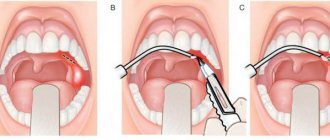Bartholinitis is an inflammation of the large Bartholin gland. The Bartholin gland, in turn, is a paired organ that is located in the subcutaneous fatty tissue of the labia majora. When a large gland in the vestibule of the vagina becomes inflamed, microorganisms affect the excretory duct of the gland (canaliculitis), as well as the gland itself.
The main function of the Bartholin gland is to produce secretions that maintain constant moisture in the vagina. What is it for?
This secretion is released in large quantities during arousal during sexual intercourse to facilitate penile insertion. In addition, secretion is very important during childbirth. Thanks to it, the vaginal muscles stretch well and the baby can be born without damaging the vaginal walls. If the Bartholin gland does not produce secretions in the required quantity, the vagina will become dry - discomfort, itching and burning in the perineum and pain during sexual intercourse will appear. Normally, this is only possible during menopause due to the age-related decrease in female estrogen hormones.
Causes of bartholinitis:
Bartholinitis occurs due to infection in the Bartholin gland through a narrow opening of the excretory duct on the inner surface of the labia minora. Once deep into the gland, microorganisms actively multiply. This leads to inflammation and suppuration of the Bartholin gland.
Not all genitourinary infections cause bartholinitis. In the vast majority of cases, bartholinitis is provoked by sexually transmitted infections. Most often it is gonorrhea, less often - trichomoniasis and chlamydia.
Bartholinitis of nonspecific etiology is extremely rare - in this case, the causative agent is bacteria - staphylococci, Escherichia coli, streptococci, and so on. This is possible if personal hygiene rules are not followed. It should also be taken into account that even in the presence of sexually transmitted infections, bartholinitis does not develop in everyone and not always.
Immunity plays an important role in the development of the disease: if it is weakened, the chances of developing bartholinitis increase.
Depending on the clinical course of the disease, bartholinitis can be acute or chronic. Acute bartholinitis is characterized by the formation of a true or false abscess of the Bartholin gland (a limited focus with pus).
When a false abscess forms, the excretory duct of the gland first becomes inflamed (“canaliculitis”, in scientific terms). The skin over the site of inflammation turns red and swells. If you press on the inflamed area, pus will come out. Next, a blockage of the excretory duct of the gland occurs and pus is no longer released, but accumulates in the Bartholin gland. Because of this, the gland is greatly stretched and protrudes, forming a painful “bump”-shaped formation. During movements - when walking, running, during sexual intercourse - the pain intensifies, and a burning sensation appears in the perineum. Sometimes body temperature rises slightly. If you do not contact a gynecologist for a long time, the disease becomes chronic.
With a true abscess, the infection penetrates directly into the Bartholin gland, and the parenchyma of the gland melts. In this case, the symptoms of the disease are more pronounced than with a false abscess. The labia majora and minora become very swollen. The body temperature rises to more than 38 degrees, the inguinal lymph nodes enlarge, chills, weakness, and “pulsating” sharp pain in the labia majora appear. Spontaneous opening of the abscess with the release of yellow-green pus is possible, which leads to a weakening of the symptoms of the disease. But if left untreated, the inflammation recurs again and gives complications, or, like a false abscess, becomes chronic.
In the chronic form of bartholinitis, the symptoms of the disease temporarily subside and worsen again. Instead of an abscess, a cyst (liquid formation with inflammatory exudate) forms in the gland.
With any form of bartholinitis, you should never self-medicate or try to squeeze out an abscess or cyst - this can lead to blood poisoning . If such symptoms occur, you should immediately consult a gynecologist.
When to contact a gynecologist
Be sure to consult a doctor if a painful nodule has formed at the entrance to the vagina, which has not changed after two to three days of self-treatment at home, for example, warm baths in this area.
If the pain is severe, make an appointment with a gynecologist immediately. If inflammation develops, no self-medication will help.
If you are already 40 years old, you should definitely consult your doctor immediately. A new lump at the vaginal opening may be a sign of a more serious problem, such as cancer. It will not be difficult for a doctor to diagnose a cyst - as a rule, a routine examination is sufficient.
Diagnosis of bartholinitis:
Diagnosing bartholinitis is not particularly difficult. The doctor will be able to make a diagnosis during examination at the first appointment. In the presence of an abscess, swelling and redness of the Bartholin gland is determined; palpation of the formation causes sharp pain. In the chronic form of bartholinitis (in the presence of a Bartholin gland cyst), a tumor-like formation is detected, painless on palpation. In addition to the examination, the following tests must be taken:
- a regular vaginal smear;
- PCR diagnosis of major sexually transmitted infections (chlamydia, gonorrhea, trichomoniasis, mycoplasmosis, ureaplasmosis, herpes, human papillomavirus);
- bacteriological culture of vaginal discharge to establish sensitivity to anitibiotics;
- bacteriological examination of pus when an abscess ruptures (or the secretion can be obtained from the excretory duct of the gland by light pressure).
Possible complications
In the absence of adequate treatment, bartholinitis can lead to the development of complications. The bulk of them are frequent relapses of the disease, transition to a chronic form. In addition, there is a possibility of the formation of a non-healing fistula and the spread of the inflammatory process to surrounding organs and tissues. In theory, bartholinitis can cause the development of sepsis - blood poisoning. However, this is only possible in patients who have an extremely low level of immune defense. For example, with HIV infection in the AIDS stage, taking cytostatic drugs.
Surgical treatment of Bartholin gland cyst:
Treatment of Bartholin gland cysts is carried out without exacerbation of the inflammatory process. In this case, there are two options for surgical intervention: marsupialization of the cyst (creation of an artificial duct of the gland for the outflow of secretions) or extirpation (removal) of the Bartholin gland.
When performing marsupilization, the doctor opens the cyst capsule with a linear incision. The edges of the capsule are sutured with separate sutures to the edges of the skin wound, forming an external opening. A drainage tube or catheter is inserted to drain the contents of the cyst. After the operation, within two months, the external opening narrows, and a new excretory duct is formed.
Extirpation of the gland is carried out in case of recurrence of bartholinitis. To do this, a longitudinal incision is made on the inside of the labia minora. The gland is carefully isolated with a scalpel and removed, and catgut sutures are placed on the wound.
For any types of bartholinitis, after surgery and complete elimination of the inflammatory process, physiotherapy is prescribed on the 3-4th day - magnetic therapy and ultraviolet irradiation. All patients are advised to abstain from sexual intercourse until complete recovery, since there is a high probability of infection of the sexual partner. In order to prevent a relapse of bartholinitis, it is important to eliminate the cause of the disease, to completely recover from concomitant infections (chlamydia, gonorrhea, etc.), otherwise bartholinitis may occur again.
All patients must observe the following rules of personal hygiene:
- wash your face twice a day;
- wear comfortable underwear, preferably cotton;
- During menstruation, change pads and tampons every 3-4 hours to avoid re-infection.
During the recovery period, it is important to use drugs that enhance the immune system. These include vitamins, a balanced diet, and some herbal immunomodulators.
We get rid of it forever
In the initial stages, bed rest is recommended, analgesic and antibacterial therapy is carried out; If the condition of the Bartholin gland cyst worsens or suppurates, surgical treatment is necessary. There are several anti-relapse surgical techniques for treating cysts. One of them is removal of the cyst; the operation can only be performed in the “cold” period, that is, until the cyst has festered. This operation is classified as a complex gynecological operation; heavy bleeding may occur during it. The least traumatic is marsupilization of a Bartholin gland cyst. The essence of this operation is that a new hole is created - the entrance to the Bartholin's gland. If this hole remains, the cyst will not form again. Complications after such surgical intervention are much less, the relapse rate is 1-2%. In our Center, both operations are performed under intravenous anesthesia. Patients are hospitalized, as a rule, for a day, then discharged home with doctor’s recommendations for postoperative treatment. The next follow-up visit to the gynecologist is in a week. If bartholinitis is detected, sexual life is contraindicated for patients due to possible infection of the partner or suppuration of the gland. Prevention of the disease consists of observing the rules of personal hygiene, excluding casual sexual intercourse, and treating vulvitis, colpitis, and urethritis.
Prevention of bartholinitis:
- regular visits to the gynecologist;
- protection against sexually transmitted infections - use of condoms, monogamous lifestyle;
- timely treatment of infections;
- strengthening the immune system: good nutrition, exercise, giving up bad habits.
In our clinic you can receive a full range of clinical and laboratory examinations before performing this surgical operation. The equipped operating room allows you to perform the operation both under local anesthesia and general anesthesia, with stay and observation in the ward for several hours.
Catheter placement
This is a modern method of surgical treatment of cysts. This is especially true when it recurs.
Under local anesthesia, the cystic area is opened with a small incision of about 5 mm, after which its contents are removed and sent for bacteriological examination, then the cyst cavity is washed and a Ward catheter is installed. This is a silicone tube 55 mm long and 5 mm in diameter, inside of which there is a channel with thinner walls at the end. By inflating a 3 ml rubber tip with 0.9% saline sodium chloride solution, the doctor fixes the catheter in the cyst cavity. For better fixation and to prevent loss during movements, it is recommended to apply 2-3 interrupted absorbable sutures along the contour of the outlet part of the catheter. The other end of the catheter is inserted into the vagina.
The catheter remains in the cyst cavity for six weeks. This is necessary to form a channel for the passage of secretions, the walls of which will not grow together. Research shows that the Word catheter is easy to use, inexpensive to install, and has acceptable short-term effects.
While the catheter is in the cavity of the cyst, the patient is recommended to be at sexual rest to avoid its loss. In some countries, such a restriction does not exist, since subsequent studies have noted that the painful symptom caused by both the cyst itself and the presence of a catheter in its cavity completely disappears by the sixth day.
As an alternative, a Jacobi ring is used. This catheter is more rigid, has no channel and is shaped like a ring. It is inserted through two punctures in the mucous membrane and in the capsule of the cyst, then the two ends of the catheter are fixed to each other.
Expert advice
Bartholinitis is a disease that can have dangerous consequences. Even a small abscess creates a risk of purulent contents escaping and rupturing the gland. The result is sepsis, requiring immediate medical intervention.
If the inflammation is not treated, bartholinitis leads to the formation of fistulas and cysts. In the future, it may be necessary to remove the Bartholin gland cyst, which will negatively affect the condition of the woman’s reproductive system.
The danger is not only acute, but also chronic bartholinitis. If not treated promptly, the infection can spread to other organs of the reproductive and genitourinary system. Among the most common complications are vulvitis, adnexitis, colpitis, and infertility.
Contact your doctor at the first sign of discomfort.
Bani Odekh Elena Yurievna
Obstetrician-gynecologist, gynecologist-endocrinologist, ultrasound diagnostics doctor, Candidate of Medical Sciences Experience 23 years
CO2 laser
CO2 laser surgery is also an effective treatment for cysts and can be performed on an outpatient basis. An incision is made in the skin with a focused laser beam, then the capsule is opened to remove the contents of the cyst, followed by internal evaporation of the damaged capsule.
Carbon dioxide ensures complete healing in an average of 22 days without the appearance of scars, bruises and wound infections. You will be able to return to your daily routine in about two days. Patients who undergo traditional surgery require 14 days to return to daily activities and 28 days for the surgical wound to fully heal. For this reason, and with the minimal risk of complications that may occur during or after surgery, CO2 laser surgery is more cost-effective than traditional treatment.








